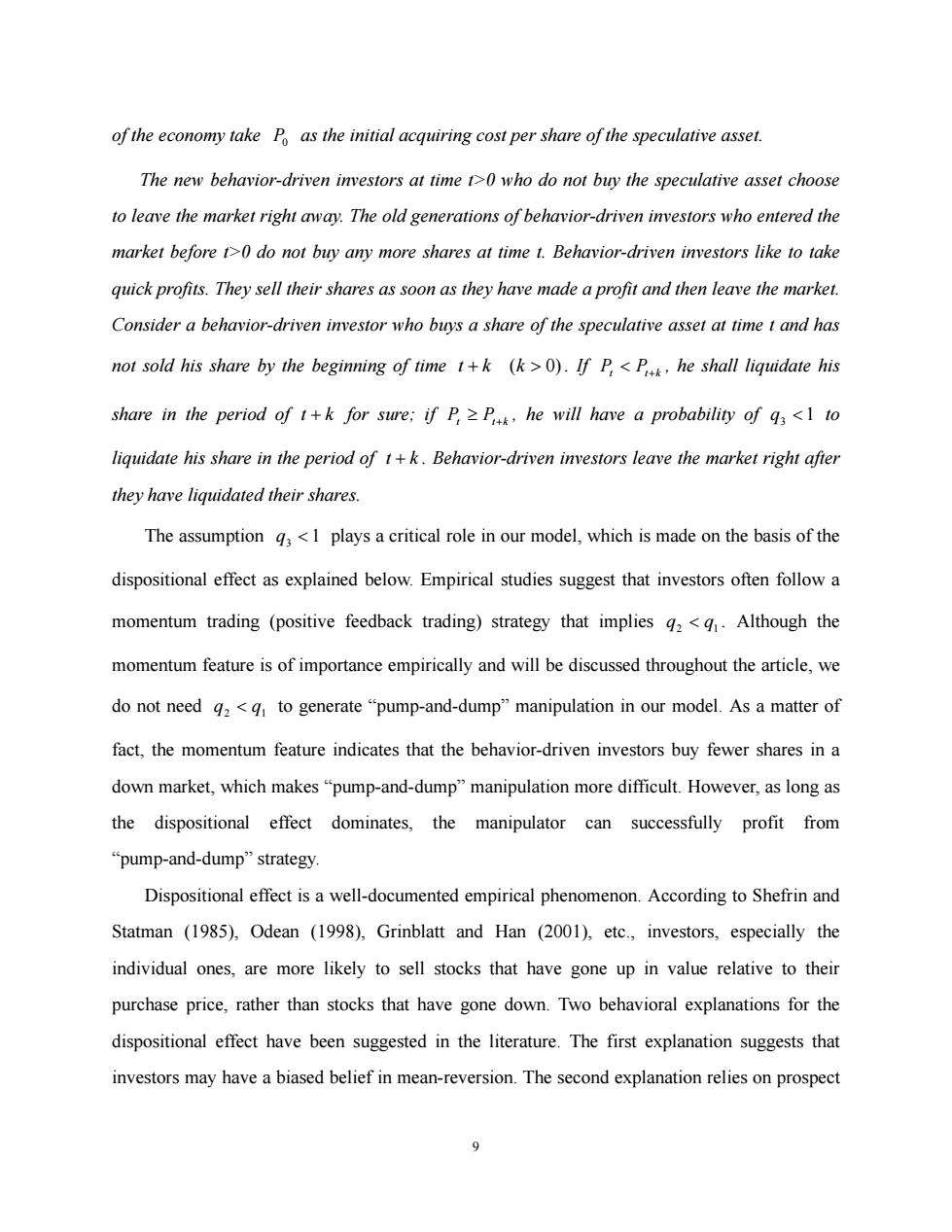正在加载图片...

of the economy take P as the initial acquiring cost per share of the speculative asset. The new behavior-driven investors at time t>0 who do not buy the speculative asset choose to leave the market right away.The old generations of behavior-driven investors who entered the market before t>0 do not buy any more shares at time t.Behavior-driven investors like to take quick profits.They sell their shares as soon as they have made a profit and then leave the market. Consider a behavior-driven investor who buys a share of the speculative asset at time t and has not sold his share by the beginning of time t+k (k>0).If P<P he shall liquidate his share in the period of t+k for sure:if P.z P he will have a probability of q3 <1 to liquidate his share in the period of t+k.Behavior-driven investors leave the market right after they have liquidated their shares. The assumption 3<1 plays a critical role in our model,which is made on the basis of the dispositional effect as explained below.Empirical studies suggest that investors often follow a momentum trading (positive feedback trading)strategy that implies q2<g.Although the momentum feature is of importance empirically and will be discussed throughout the article,we do not need q2<q to generate"pump-and-dump"manipulation in our model.As a matter of fact,the momentum feature indicates that the behavior-driven investors buy fewer shares in a down market,which makes"pump-and-dump"manipulation more difficult.However,as long as the dispositional effect dominates,the manipulator can successfully profit from “pump-and-dump”strategy. Dispositional effect is a well-documented empirical phenomenon.According to Shefrin and Statman (1985),Odean (1998),Grinblatt and Han (2001),etc.,investors,especially the individual ones,are more likely to sell stocks that have gone up in value relative to their purchase price,rather than stocks that have gone down.Two behavioral explanations for the dispositional effect have been suggested in the literature.The first explanation suggests that investors may have a biased belief in mean-reversion.The second explanation relies on prospect 99 of the economy take P as the initial acquiring cost per share of the speculative asset. 0 The new behavior-driven investors at time t>0 who do not buy the speculative asset choose to leave the market right away. The old generations of behavior-driven investors who entered the market before t>0 do not buy any more shares at time t. Behavior-driven investors like to take quick profits. They sell their shares as soon as they have made a profit and then leave the market. Consider a behavior-driven investor who buys a share of the speculative asset at time t and has not sold his share by the beginning of time t + k (k > 0) . If Pt < Pt+k , he shall liquidate his share in the period of t + k for sure; if Pt ≥ Pt+k , he will have a probability of q to 3 < 1 liquidate his share in the period of t + k . Behavior-driven investors leave the market right after they have liquidated their shares. The assumption 1 q3 < plays a critical role in our model, which is made on the basis of the dispositional effect as explained below. Empirical studies suggest that investors often follow a momentum trading (positive feedback trading) strategy that implies 2 1 q < q . Although the momentum feature is of importance empirically and will be discussed throughout the article, we do not need 2 1 q < q to generate “pump-and-dump” manipulation in our model. As a matter of fact, the momentum feature indicates that the behavior-driven investors buy fewer shares in a down market, which makes “pump-and-dump” manipulation more difficult. However, as long as the dispositional effect dominates, the manipulator can successfully profit from “pump-and-dump” strategy. Dispositional effect is a well-documented empirical phenomenon. According to Shefrin and Statman (1985), Odean (1998), Grinblatt and Han (2001), etc., investors, especially the individual ones, are more likely to sell stocks that have gone up in value relative to their purchase price, rather than stocks that have gone down. Two behavioral explanations for the dispositional effect have been suggested in the literature. The first explanation suggests that investors may have a biased belief in mean-reversion. The second explanation relies on prospect